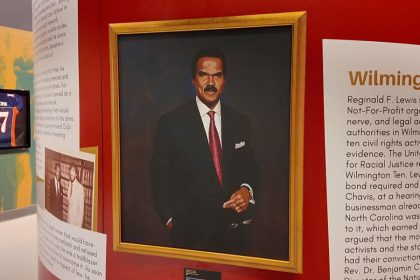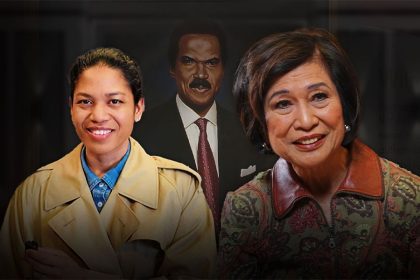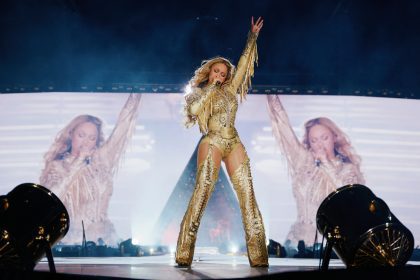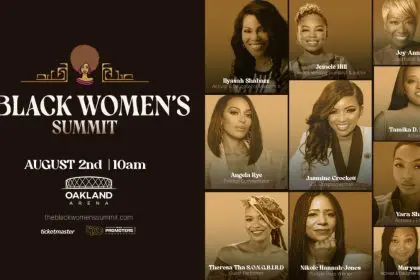In the heart of Baltimore stands a beacon of light, the Reginald F. Lewis Museum of Maryland African American History & Culture. Within its walls, a new exhibition called “TITAN | The Legacy of Reginald F. Lewis” invites visitors to step into the world of the museum’s namesake, a man whose extraordinary life journey from Baltimore to Harvard Law School to becoming America’s first Black billionaire through leveraged buyouts challenged the notion that success at that level was reserved for others.
The exhibition’s curator, Robert Parker, has created more than a display of artifacts, he’s designed a transformative experience that allows visitors to connect intimately with Lewis’s spirit. “We wanted to make certain that story came out,” Parker explains during his conversation with Munson Steed on Design and Dialogue, “because I think that’s one of those lesser known and more undocumented ones.”
The man behind the museum
For twenty years, the Reginald F. Lewis Museum has told the stories of Black Marylanders, but strangely, never fully explored the life of its own namesake. Parker saw this anniversary year as the perfect moment to correct that oversight.
“In that 20-year period, there’s never been a comprehensive sort of examination of the namesake for the institution,” Parker notes. “We thought it was time. It was overdue actually to celebrate this legend, and to have the world understand in greater depth who he was and how his legacy has this indelible connection on all of us.”
What emerges in the exhibition is not a mythologized icon placed on a pedestal but a fully realized human being whose strength, determination, and family values offer powerful lessons for today’s dreamers and doers.
Three takeaways for visitors
Parker hopes visitors leave with three primary insights after experiencing TITAN:
First, Lewis’s incredible strength of purpose. “He was very stick-to-itive in his quest for success,” says Parker. “He was early on focused, and he knew what he wanted out of life.” Parker points to Lewis’s undergraduate declaration that he would become “the richest African American in the world”, a goal he ultimately achieved.
Second, his unrelenting determination. This quality manifested across every aspect of Lewis’s life, from his early days as a high school triathlete excelling in basketball, football, and baseball to his college years at Virginia State University. When an injury sidelined his athletic career, Lewis channeled that same energy into academics.
“He created this schedule that we actually show,” Parker explains. “That handwritten schedule was a very focused, regimented, methodical way for him to succeed in college.” This physical artifact offers visitors a tangible connection to Lewis’s disciplined approach.
Third, the humanization of a business icon. While many know Lewis as a corporate titan and philanthropist, Parker wanted to reveal “the more or softer side of Reginald F. Lewis. Reginald F. Lewis as a family man, as a father, as a husband.”
Designing immersion as transformation
What makes TITAN remarkable is its approach to immersion. Rather than simply displaying items in cases, Parker and his team have recreated spaces from Lewis’s life, his office desk, his private jet, allowing visitors to physically enter his world.
“I think it’s important for every visitor to be able to have a connection to the stories we’re trying to tell in a tangible way,” Parker explains. “How do we make that real for someone? I think relevance and provocation helps that.”
The jet installation, which Parker calls “the jet setter,” particularly stands out. “This was an African American man in the eighties flying around in a jet,” he notes. Lewis referred to it as “the ultimate perk.” By recreating this environment and complementing it with photographs of Lewis in his aircraft, the exhibit transforms abstract success into concrete reality.
This immersive design philosophy extends throughout the exhibition. Steed describes the experience as transformative: “In each space I never felt crowded and I felt like I was going through another door. I felt like I was taking another trip.”
Parker confirms this was intentional: “We didn’t want a linear experience, and we wanted people to be able to start in any aspect of this exhibit.” The design incorporates geometric shapes reminiscent of the museum’s architecture, creating visual continuity between the building and the exhibition while allowing visitors to get “lost in the story.”
A pilgrimage for entrepreneurs
For aspiring business leaders, especially entrepreneurs of color, Parker suggests the exhibition offers something special, an opportunity to see oneself in Lewis’s journey.
“I think, for people to come to the Lewis Museum to experience the TITAN exhibit is again an opportunity for them to see how real Reginald F. Lewis was,” he says. “I think, in history, typically we like to romanticize figures, and we like to put individuals on pedestals, and I think we’ve done the opposite.”
The exhibition doesn’t shy away from Lewis’s setbacks or struggles. Instead, it presents them as essential parts of his journey, embracing his philosophy to “keep going, no matter what.” Parker explains: “I think we did our best to humanize him in a way where you can see his lessons learned, and you can see how he bounced back from failure.”
This approach makes Lewis’s extraordinary achievements feel accessible rather than superhuman. The man who engineered the $985 million leveraged buyout of Beatrice International Foods in 1987, then the largest offshore transaction in American history, is presented as someone whose success came through persistence and resilience, qualities anyone can cultivate.
A space to fill up
Perhaps the most powerful aspect of the exhibition is how it creates what Steed calls “a space to fill up,” room for visitors to see themselves in Lewis’s story and imagine their own possibilities.
As Steed observes, “For any child born in Baltimore or Maryland to walk in there, I think he gives them a pedigree that they didn’t give themselves. He says it’s yours, so you can claim it. It’s in you.”
This sentiment echoes the title of Lewis’s autobiography, “Why Should White Guys Have All the Fun?” — a provocative question that challenged racial barriers in American business and continues to inspire new generations of entrepreneurs.
Through thoughtful curation and immersive design, Parker has created more than an exhibition. He’s built a space where visitors can discover, as Steed puts it, “that there’s a TITAN waiting to be opened in your spirit each and every day.”
The TITAN exhibition at the Reginald F. Lewis Museum in Baltimore offers that rare opportunity, a chance not just to learn about history, but to step into it, be transformed by it, and emerge with a new understanding of what’s possible.















